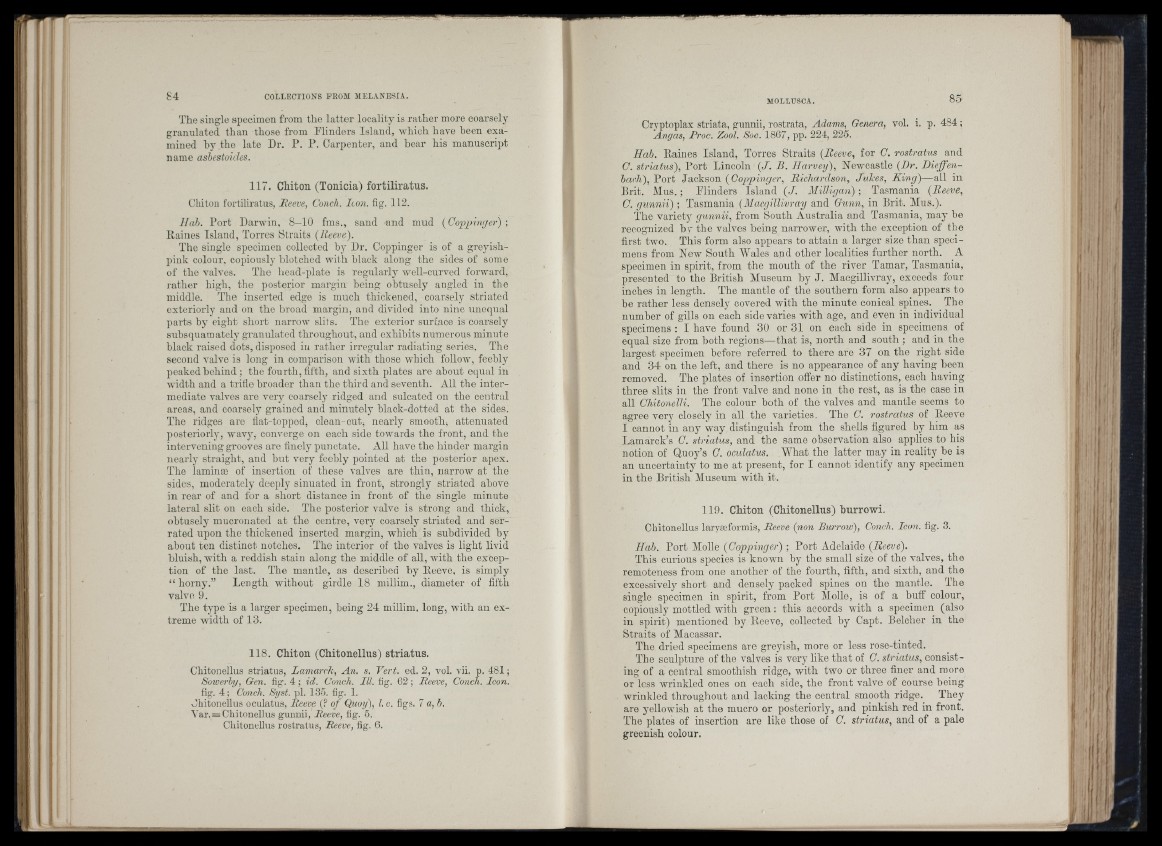
The single specimen from the latter locality is rather more coarsely
granulated than those from Flinders Island, which have been examined
by the late Dr. P. P. Carpenter, and hear his manuscript
name asbestoides.
117. Chiton (Tonicia) fortiliratus.
Chiton fortiliratus, Peeve, Conch. Icon. fig. 112.
Uab. Port Darwin, 8—10 fms., sand and mud (Coppinger) ;
Kaines Island, Torres Straits (Reeve).
The single specimen collected by Dr. Coppinger is of a greyish-
pink colour, copiously blotched with black along the sides of some
of the valves. The hcad-plate is regularly well-curved forward,
rather high, the posterior margin being obtusely angled in the
middle. The inserted edge is much thickened, coarsely striated
exteriorly aud on the broad margin, and divided into nine unequal
parts by eight short narrow slits. The exterior surface is coarsely
subsquamately granulated throughout, and exhibits numerous minute
black raised dots, disposed iu rather irregular radiating series. The
second valve is long in comparison with those which follow, feebly
peaked behind ; the fourth, fifth, and sixth plates are about equal in
width and a trifle broader than the third and seventh. All the intermediate
valves are very coarsely ridged and sulcated on the central
areas, and coarsely grained and minutely black-dotted at the sides.
The ridges are fiat-topped, clean-cut, nearly smooth, attenuated
posteriorly, wavy, converge on each side towards the front, and the
intervening grooves are finely punctate. All have the hinder margin
nearly straight, and bnt very feebly pointed a t the posterior apex.
Tlie lamina? of insertion of these valves are thin, narrow at the
sides, moderately deeply sinuatcd in front, strongly striated above
in rear of and for a short distance in front of the single minute
lateral slit on each side. The posterior valve is strong and thick,
obtusely mucronated at the centre, very coarsely striated and serrated
upon the thickened inserted margin, which is subdivided by
about ten distinct notches. The interior of the valves is light livid
hluish, w ith a reddish stain along the middle of all, with the exception
of the last. The mantle, as described by lleeve, is simply
“ horny.” Length without girdle 18 millim., diameter of filth
valve 9.
The tj+ e is a larger specimen, being 24 millim. long, with an extreme
width of 13.
118. Chiton (Chitonellus) striatus.
Cliitonellus striatus, Lamarck, An. s. Vert. ed. 2, vol. vii. p. 481;
Sowerby, Gen. fig. 4 ; id. Conch. III. fig. 62; Peeve, Conch. Icon.
fig. 4; Conch. Syst. pi. 13o. fig. 1.
Jhitonellus oculatus, Peeve (? of Quoy), I. c. figs. 7 a, b.
A’ar. = Chitonellus guiiuii, Peeve, tig. 5.
Cliitonellus rostratus, Reeve, fig. 6.
I if
Cryptoplax striata, gunnii, rostrata, Adams, Genera, vol. i. p. 434;
“Angas, Proc. Zool. Soc. 1867, pp. 224, 225.
Hab. Eaines Island, Torres Straits (Peeve, for C. rostratus and
C. striatus). Port Lincoln (J. B. Harvey), Newcastle (Dr. Dieffen-
bach). Port Jackson (Oopp>inger, Bichardson, Juices, King)—all in
Brit. M u s.; Flinders Island (J. Milligan) ; Tasmania (Beeve,
C. g u n n ii) ; Tasmania (Mac.gillivray and Gunn, in Brit. Mus.).
The variety gunnii, from South Australia and Tasmania, may be
recognized by the valves being narrower, with the exception of the
first tAvo. This form also appears to attain a larger size than specimens
from New South Wales and other localities further north. A
specimen in spirit, from the mouth of the riAmr Tamar, Tasmania,
presented to the ilritish Museum by J. Macgillivray, exceeds four
inches in length. The mantle of the southern form also appears to
be rather less densely covered with the minute conical spines. The
number of gills on each side varies Avith age, and even in individual
specimens ; I have found 30 or 31 on each side in specimens of
equal size from both regions—th at is, north and south ; and in the
largest specimen before referred to there are 37 on the right side
and 34 on the left, and there is no appearance of any having been
removed. The plates of insertion offer no distinctions, each having
three slits in the front valve and none in the rest, as is the case in
all ChitonelU. The colour both of the valves and mantle seems to
agree very closely in all the varieties. The C. rostratus of IleoA-e
I cannot in any way distinguish from the shells figured by him as
Lamarck’s 0. striatus, and the same observation also applies to his
notion of Quoy’s G. oculatus. .What the latter may in reality be is
an uncertainty to me at present, for I cannot identify any specimen
in the British Museum vidth it.
119. Chiton (Chitonellus) hnrrowi.
Cliitonellus laryEeformis, Beeve (non Burrow), Conch. Icon. fig. 3.
Hah. Port Molle (Coppinger) ; Port Adelaide (Beeve).
This curious species is known by the small size of tho valves, tho
remoteness from one another of the fourth, fifth, and sixth, and the
excessively short and densely packed spines on the mantle. The
single specimen in spirit, from Port Molle, is of a buff colour,
copiously mottled with green : this accords with a specimen (also
in spirit) mentioned by lleeA’o, collected by Capt. Belcher in the
Straits of Macassar.
The dried specimens are greyish, more or less rose-tinted.
The sculpture of the valves is very like th at of G. striatus, consisting
of a central smoothish ridge, with two or three finer and more
or less wrinkled ones on each side, the front vah’e of course being
wrinkled throughout and lacking the central smooth ridge. They
are yellowish at the mucro or posteriorly, and pinkish red in front.
The plates of insertion are like those of C. striatus, and of a pale
greenish colour.